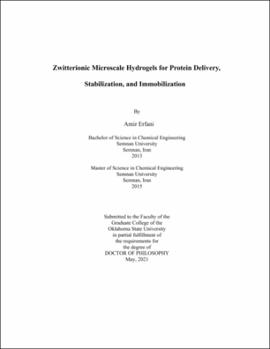| dc.description.abstract | Proteins are incredibly useful in medicine and industrial chemistry. Many of the most recent breakthroughs in cancer therapy are based on monoclonal antibody treatments. Yet, there are major difficulties that can act as deterrents in developments of such therapies. Sustained subcutaneous, oral or pulmonary deliveries of such therapeutics are limited by the poor stability, short half-life, and non-specific interactions between the therapeutic biomolecules (e.g. antibody) and the delivery vehicle. Similarly, usage of proteins as enzymes in processes is limited by poor stability, short half-life, and difficulties with reusability. With growing usage of proteins as pharmaceuticals and biocatalysts, and apparent shortcomings in both fields, there is a growing need to design materials that are protein compatible and can improve protein stability. The key to successfully utilizing proteins as therapeutics, biocatalysts or biosensors is to maintain their conformation and function. There is emerging evidence that biomimetic, biocompatible zwitterionic polymers can prevent non-specific interactions within protein systems and increase protein stability. In this work, zwitterionic microscale hydrogels of two different zwitterionic moieties (carboxybetaine and sulfobetaine), were synthesized. For the purpose of protein delivery, a biodegradable zwitterionic poly(carboxybetaine), pCB, based microscale hydrogel (microgel) covalently crosslinked with tetra(ethylene glycol) diacrylate was synthesized for antibody encapsulation. The resulting microgels were characterized via FTIR, diffusion NMR, SANS, and cell culture studies. The microgels were found to contain up to 97.5% water content and showed excellent degradability that can be tuned with crosslinking density. Cell compatibility of the microgel was studied by assessing the toxicity and immunogenicity in vitro. Cells exposed to the microgel showed complete viability and no pro-inflammatory secretion of interleukin 6 (IL6) or tumor necrosis factor-alpha (TNFa). The microgel was loaded with Immunoglobulin G (as a model antibody), using a post-fabrication loading technique, and antibody sustained release from microgels of varying crosslinking densities was studied. The released antibodies (especially from the high crosslinked microgels) proved to be completely active and able to bind with antibody receptors. Furthermore, for the purpose of protein immobilization, a reaction scheme was developed and studied for covalent immobilization of the protein (a-chymotrypsin) (ChT) within the zwitterionic microscale hydrogels. Confocal laser microscopy studies showed that immobilized ChT (i-ChT) was distributed within the hydrogel. The enzyme-immobilized microgels showed excellent reusability (72% of its initial activity after 10 uses) and could undergo several freezing/drying/rehydration cycles while retaining enzymatic activity. The i-ChT activity, half-life, and conformational stability were studied at varying pH and temperatures with results compared to free ChT in buffer. ChT immobilized within pCB hydrogel showed increased enzymatic stability as observed by a 13 degrees C increase in the temperature at which i-ChT loses activity compared to free ChT. Furthermore, enzyme half-life increased up to seven-fold for the pCB immobilized ChT, and the increased stability resulted in higher activity at elevated pH. The i-ChT was most active at pH of 8.5 and was partially active up to the pH of 10.2. This research paves the way for designing protein delivery vectors as well as fabrication of enzyme immobilized materials with extended enzyme lifetime and activity. | |
